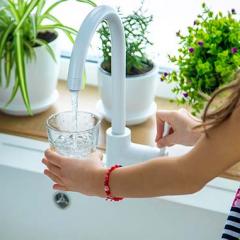After weeks at home in isolation, some unusual eating habits may have crept in, along with a few extra inches around the waistline. And it isn’t hard to understand why! The uncertainty of the duration of our current situation, daily proximity to the pantry, fridge and baking facilities, and increase in anxiety and boredom which triggers a desire for comfort eating, all have their own role to play.
However, instead of dwelling on the negatives, what if you used this time as an opportunity to turn your home into a mini health retreat? Why not take action to set a new healthy eating routine that will have a domino effect on your mental and physical well-being now and into the future?
Whether or not healthy eating habits were part of your daily life before COVID-19, being at home and 100% in control of your schedule provides a number of opportunities. It is the perfect time to develop new habits and strengthen them through daily routine. By the time you are back to normal, these new habits will have become second nature.
But where do you start? Here are some helpful tips:
1. What’s not in the pantry cannot get to the mouth!
Select groceries not according to their packaging claims, or their convenience, but according to their list of ingredients. The groceries bought in person or via the online supermarket must have naturally occurring health characteristics first and foremost.
Overwhelmed by food labels, check out this helpful article.
2. Choose foods closest to the harvesting state (fresh, frozen, dried or canned) and high in fibre over highly processed
This allows for greater satiation and satiety (= less overeating), and provides the right “food” for the gut bacteria, which in turn produces the chemicals that are mood-uplifting and immune-strengthening.
3. Learning to become an expert in the kitchen is excellent and great fun! However selecting the area of expertise is key
Replace baking fancy cakes with pickling (seasonal vegetables), preserving (seasonal fruit and vegetables), sprouting (seeds and legumes) and fermenting (yoghurt, kefir). All these increase your selection of healthy snacks and meal ingredients, as well as benefiting your gut bacteria.
Another option is to become an expert at modifying recipes. For instance, reduce the sugar and fat, and increase the fibre content of baked goods.
4. Setting a routine of health habits
- A daily target for pure water drinking that replaces soft drinks and commercial fruit juice. Blend whole citrus fruit with vegetables and plenty of water for flavoured drinks.
- When snacking between meals replace crackers and biscuits with raw crunchy vegetables: carrots, celery, cucumber, fennel, turnip, radish etc.
- Have the main meal (in terms of energy content) in the middle of the day, and a light dinner.
- Experiment and find the most convenient way to incorporate fasting:
- fasting with water only for half a day, or a whole day weekly
- dropping to an intake of 2000 kilojoules for one or 2 days weekly
- sticking to an 8 to 10 hour window of eating and a 14 to 16 hour window of fasting daily - If drinking alcohol: the new recommendations for safe drinking are to have no more than 10 standard drinks spread through the week. The energy yield of alcohol is substantial, almost as much as fat, and must therefore be considered in the overall intake. Can it be replaced by blended spicy fruit and vegetable mocktails?
5. Address the need to comfort eat: while these are challenging times on many fronts, it is worthwhile to realise that food is simply food
Food makes one feel better for a while (the reason behind comfort eating) because of the pleasure experienced from tastes and textures, which releases feel-good chemicals in the brain, allowing for a more positive outlook on life. This release of chemicals can be triggered in other ways too: a walk in the park, an intense exercise session, listening to upbeat music, practicing meditation and mindfulness, breathing exercises, laughter, completing a long-overdue task, or de-cluttering and organising a room in the house. Making a list of the activities that result in that feel-good chemical release will prepare you for the next time anxiety or stress is felt. First, see if one of the activities helps and then, if still needed, go for a healthy tasty snack!
Using the extended time at home to reset eating habits and develop a routine will result in long lasting health outcomes; because a routine is the strong engine behind any successful health plan. Any small step in the right direction is worthwhile. Choose the one that appears most doable and build up from there. Your waistline will thank you for it!
If you are concerned about your relationship with food or you want to talk about how you can build some new healthy habits, you may benefit from talking with an Accredited Practising Dietitian. Find out more and book an appointment here.
 Author: Dr Veronique Chachay is the coordinator and lecturer of the nutrition science courses in the undergraduate nutrition major programs, and the applied food science for dietetics course in the Master on Dietetics Studies, in the School of Human Movement and Nutrition Sciences. Her nutrition science expertise is applied in a wide range of research fields, including regulation of energy expenditure via brown fat activation, dietary factors modulating alpha diversity in inflammatory bowel disease, and energy intake meeting requirements in motor neuron disease.
Author: Dr Veronique Chachay is the coordinator and lecturer of the nutrition science courses in the undergraduate nutrition major programs, and the applied food science for dietetics course in the Master on Dietetics Studies, in the School of Human Movement and Nutrition Sciences. Her nutrition science expertise is applied in a wide range of research fields, including regulation of energy expenditure via brown fat activation, dietary factors modulating alpha diversity in inflammatory bowel disease, and energy intake meeting requirements in motor neuron disease.



